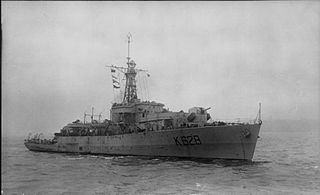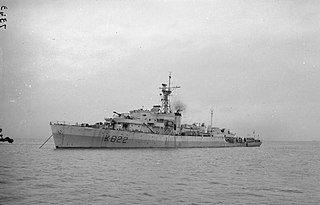
The sixth HMS Bulwark of the Royal Navy was a 22,000 ton Centaur-class light fleet aircraft carrier. Initially commissioned as a light aircraft carrier in 1954, the ship was converted into a commando carrier in 1958 and recommissioned as such in 1960. Bulwark remained in this capacity until 1979 following failed efforts to sell the ship, Bulwark re-entered service as an anti-submarine warfare carrier and remained as such until being decommissioned in 1981. The ship was scrapped in 1984.

HMS Loch Fada was the lead ship of the Loch-class frigates of the British Royal Navy, built by John Brown & Company of Clydebank, Scotland, and named after Loch Fada in the Inner Hebrides.

HMS Loch Insh was a Loch-class frigate of the Royal Navy, named after Loch Insh in Scotland. She was built by Henry Robb of Leith and launched on 10 May 1944. After service at the end of World War II she was decommissioned, but reactivated in 1950 and served, mostly in the Persian Gulf, until 1962. The ship was sold to the Royal Malaysian Navy in 1963 and renamed KD Hang Tuah (F433). She was scrapped in 1977.

HMS Loch Killisport (K628/F628) was a Loch-class frigate of the British Royal Navy, named after Loch Killisport in Scotland. Launched in 1944, the ship was not commissioned until July 1945, and served in post-war repatriation operations in the Far East until decommissioned in April 1946. During this time Prince Philip was an officer on board this ship. Recommissioned in 1950 she served in the Home Fleet for two years, before being extensively modernised for service in the Persian Gulf and Far East. Decommissioned in August 1965, she was sold for scrapping in 1970.

HMS Morecambe Bay was a Bay-class anti-aircraft frigate of the British Royal Navy, named after Morecambe Bay on the north western coast of England. In commission from 1949 until 1956, she saw active service in the Korean War, and was sold to Portugal in 1961 to serve as NRP Dom Francisco de Almeida until 1970.

HMS Euryalus (F15) was a Leander-class frigate of the Royal Navy (RN). Like the rest of the class, Euryalus was named after a figure of mythology. Euryalus was built by Scotts Shipbuilders of Greenock. Euryalus was launched on 6 June 1963, and commissioned on 16 September 1964.

HMS Hydra was a Royal Navy deep ocean hydrographic survey vessel, the third of the original three of the Hecla class. The ship was laid down as yard number 2258 on 14 May 1964 at Yarrow Shipbuilders, at Scotstoun on the River Clyde and launched on 14 July 1965 by Mary Lythall, wife of the then Chief Scientist, Basil W Lythall CB (1919–2001). She was completed and first commissioned on 4 May 1966 and, as the replacement for the survey ship HMS Owen, her commanding officer and many of her ship's company formed the first commission of HMS Hydra. She was decommissioned and sold to the Indonesian Navy in 1986 and renamed KRI Dewa Kembar ; she was still in service in 2019.

HMS Burghead Bay was a Bay-class anti-aircraft frigate of the British Royal Navy, named for Burghead Bay in Morayshire.

HMS Cardigan Bay was a Bay-class anti-aircraft frigate of the British Royal Navy, named after Cardigan Bay, off the coast of Ceredigion, Wales.
HMS St Austell Bay was a Bay-class anti-aircraft frigate of the British Royal Navy, named after St Austell Bay on the south coast of Cornwall. In commission from 1945 until 1956, she served in the Mediterranean Fleet and on the America and West Indies Squadron.
HMS St Brides Bay was a Bay-class anti-aircraft frigate of the British Royal Navy, named for St Brides Bay in Pembrokeshire. In commission from 1945 to 1961, she served in the Mediterranean and Eastern Fleets, seeing active service in the Korean War.

HMS Veryan Bay was a Bay-class anti-aircraft frigate of the British Royal Navy, named after Veryan Bay on the south coast of Cornwall. In commission from 1945 until 1957, she saw service in the Pacific, Mediterranean, and Home Fleets, in the West Indies and in the South Atlantic.

HMS Whitesand Bay was a Bay-class anti-aircraft frigate of the British Royal Navy, named for Whitesand Bay in Cornwall. In commission from 1945 to 1954, she served in the Pacific, Mediterranean, West Indies and Far East Fleets, seeing active service in the Korean War.

HMS Dalrymple was a Bay-class anti-aircraft frigate of the British Royal Navy, which served as a survey ship, mostly in the Persian Gulf, from 1948 until 1965. She was completed to deal with the large numbers of uncharted wrecks and mines around the British Isles as a result of World War II. For this purpose she was fitted for minesweeping. She was named for the pioneering Hydrographer of the Admiralty Alexander Dalrymple (1737–1808).
HMS Dampier was a survey ship of the Royal Navy, named after the explorer, author and privateer, William Dampier (1652–1715). Originally intended as a Bay-class anti-aircraft frigate, the ship was in commission from 1948 to 1968, spending her entire career based at Singapore, carrying out survey work.

HMS Loch Fyne was a Loch-class frigate of the British Royal Navy, built by the Burntisland Shipbuilding Company Ltd, Burntisland, Fife, Scotland, and named after Loch Fyne in Scotland. The ship was launched in 1944, and served at the end of World War II. Recommissioned in 1951, she served in the Persian Gulf and was scrapped in 1970.

The first USS Swan (AM-34/AVP-7) was a Lapwing-class minesweeper acquired by the United States Navy.

HMNZS Rotoiti (F625) was a Loch-class frigate of the Royal New Zealand Navy (RNZN), which had formerly served in the British Royal Navy as HMS Loch Katrine at the end of World War II.

HMNZS Hawea (F422), formerly HMS Loch Eck (K422), was one of six Loch-class frigates that served in both the Royal Navy (RN) and the Royal New Zealand Navy (RNZN). The ship was laid down by Smiths Dock on 25 October 1943, launched on 25 April 1944 and commissioned into the Royal Navy as HMS Loch Eck on 7 November 1944.

HMS Loch Achray was a Loch-class frigate of the Royal Navy. She was built by Smith's Dock Co. Ltd. in South Bank-on-Tees and launched on 7 July 1944. After service in World War II, she was sold to the Royal New Zealand Navy and renamed HMNZS Kaniere (F426) in September 1948. After service in the Korean War, she was used as a training ship from 1957. She was sold in 1966 for breaking up in Hong Kong.

















